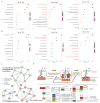Proteomics Reveals the Role of PLIN2 in Regulating the Secondary Hair Follicle Cycle in Cashmere Goats
- PMID: 40141352
- PMCID: PMC11942475
- DOI: 10.3390/ijms26062710
Proteomics Reveals the Role of PLIN2 in Regulating the Secondary Hair Follicle Cycle in Cashmere Goats
Abstract
Based on comprehensive proteomic analysis conducted across various stages of secondary hair follicles (SHFs), the growth and development regulatory mechanisms of SHFs in Jiangnan cashmere goats were studied. Proteomic analysis of skin tissue from the SHF anagen (An), catagen (Cn), and telogen (Tn) revealed 145 differentially expressed proteins (DEPs) between the An and Tn, 53 DEPs between the Cn and An, and 168 DEPs between the Cn and Tn. Gene Ontology (GO) annotations indicated that the DEPs were predominantly involved in keratin filament formation (KRTAP3-1, KRT1, KRT8), intermediate filament formation (KRT26, KRT35, KRT19, etc.), and lipid metabolism (FA2H, CERS6, ECH1, TECR, etc.). Furthermore, Kyoto Encyclopedia of Genes and Genomes (KEGG) pathway enrichment analysis identified significant enrichment of DEPs in pathways related to hair follicle growth and development. Notably, these included the PPAR signaling pathway (PLIN2, PLIN4, ACSL5, etc.), the IL-17 signaling pathway (S100A7A, LOC108633164), and the estrogen signaling pathway (KRT26, KRT35, LOC102176457.). Western blotting (WB) experiments were then performed on five DEPs (KRT28, FA2H, PLIN2, FABP7, and VNN1) to validate the consistency of the WB results with the proteomic data. Overexpression and siRNA interference of PLIN2 in dermal papilla cells (DPCs) were followed by CCK8 and flow cytometry assays, revealing that PLIN2 knockdown significantly decreased DPC proliferation while inducing apoptosis, compared to controls. These findings suggest that the PLIN2 gene plays a crucial role in modulating SHF growth cycles in cashmere goats by influencing DPC proliferation. These results provide novel insights that could inform the development of breeding strategies aimed at enhancing the cashmere yield in such goats.
Keywords: Jiangnan cashmere goats; PLIN2; proteomics; secondary hair follicle cycle.
Conflict of interest statement
The authors declare no conflicts of interest.
Figures




Similar articles
-
Comparative proteomic analysis of the telogen-to-anagen transition in cashmere goat secondary hair follicles.Front Vet Sci. 2025 Feb 25;12:1542682. doi: 10.3389/fvets.2025.1542682. eCollection 2025. Front Vet Sci. 2025. PMID: 40070920 Free PMC article.
-
Transcriptome sequencing reveals differences between anagen and telogen secondary hair follicle-derived dermal papilla cells of the Cashmere goat (Capra hircus).Physiol Genomics. 2014 Feb 1;46(3):104-11. doi: 10.1152/physiolgenomics.00132.2013. Epub 2013 Dec 10. Physiol Genomics. 2014. PMID: 24326349
-
Regulation of secondary hair follicle cycle in cashmere goats by miR-877-3p targeting IGFBP5 gene.J Anim Sci. 2023 Jan 3;101:skad314. doi: 10.1093/jas/skad314. J Anim Sci. 2023. PMID: 37777862 Free PMC article.
-
Melatonin's Role in Hair Follicle Growth and Development: A Cashmere Goat Perspective.Int J Mol Sci. 2025 Mar 21;26(7):2844. doi: 10.3390/ijms26072844. Int J Mol Sci. 2025. PMID: 40243438 Free PMC article. Review.
-
Deciphering the molecular drivers for cashmere/pashmina fiber production in goats: a comprehensive review.Mamm Genome. 2025 Mar;36(1):162-182. doi: 10.1007/s00335-025-10109-z. Epub 2025 Feb 4. Mamm Genome. 2025. PMID: 39904908 Review.
References
-
- Qin C., Du J., Li B., Jia Y., Mai’erhaba A., Ayinuran A. Investigation on the Development of Cashmere Goat Industry in Southern Xinjiang of Aksu Region. Appl. Eng. Technol. 2023;43:13–15.
-
- Yin R., Wang Y., Wang Z., Zhu Y., Cong Y., Wang W., Deng L., Liu H., Guo D., Bai W. Discovery and molecular analysis of conserved circRNAs from cashmere goat reveal their integrated regulatory network and potential roles in secondary hair follicle. Electron. J. Biotechnol. 2019;41:37–47. doi: 10.1016/j.ejbt.2019.06.004. - DOI
-
- Parry A.L., Norton B.W., Restall B.J. Skin follicle development in the Australian cashmere goat. Aust. J. Agric. Res. 1992;43:857–870. doi: 10.1071/AR9920857. - DOI
-
- Liu Y., Wang L., Li X., Han W., Yang K., Wang H., Zhang Y., Su R., Liu Z., Wang R., et al. High-throughput sequencing of hair follicle development-related micrornas in cashmere goat at various fetal periods. Saudi J. Biol. Sci. 2018;25:1494–1508. doi: 10.1016/j.sjbs.2017.12.009. - DOI - PMC - PubMed
MeSH terms
Substances
Grants and funding
LinkOut - more resources
Full Text Sources
Research Materials
Miscellaneous

